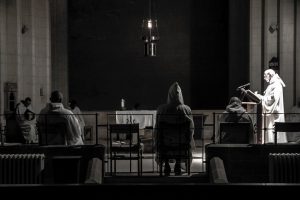Archive, Articles
New Monasticism
In one of the sayings handed on to us from the Desert Fathers, a young man asks an abba, ‘Father, what is a monk?’ The abba replies, ‘A monk is someone who asks himself every day, “What is a monk?”’ A degree of self-questioning is intrinsic to monasticism, which seeks to be a response of discipleship rooted in a here, a now. In that respect, monasticism is always ‘new’. A sign of monastic authenticity is that monks or nuns have a spring in their step, a clear sense of purpose; that their endeavour is a present response to a present call, not the mere execution of arcane customs. That said, there are elements of monasticism that are timeless and unchanging. First, the monk is bound to a solitude of heart that requires him to be celibate. The covenant he makes with the Lord is an exclusive, nuptial covenant. Like marriage vows, his are binding until death. Monasticism is by consequence—as a second hallmark—a life-time commitment. A third characteristic is a radical renunciation of autonomy. The monk lives within a community of shared goods, where he calls nothing his own. He even makes an oblation of his will, consecrated to the Lord in an obedience that finds embodied form in human authority blessed by the Church. Where these elements are not present, there can be no monastic life. This is not to say that the monastic charism does not extend beyond the enclosure wall. There have always been groups of believers gathering around monasteries in more or less defined configurations. The enabling of such groups is part of a monastery’s outreach and mission. It seems to me, however, that little is gained by blurring categories. To call something (an institution, an initiative) ’monastic’ when it is not, is to take away from the possibly genuine newness of what is coming into being while eroding the specificity of a definite charism. What is called for, I’d suggest, is a relationship of complementarity based on conversation and friendship. From this, everyone stands to gain.

